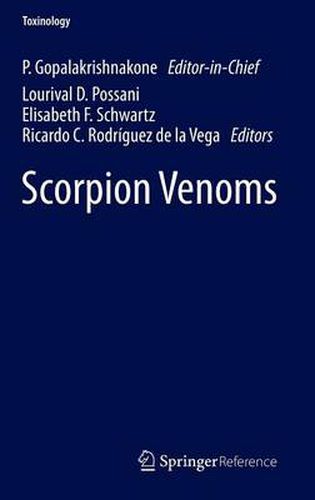Readings Newsletter
Become a Readings Member to make your shopping experience even easier.
Sign in or sign up for free!
You’re not far away from qualifying for FREE standard shipping within Australia
You’ve qualified for FREE standard shipping within Australia
The cart is loading…






This title is printed to order. This book may have been self-published. If so, we cannot guarantee the quality of the content. In the main most books will have gone through the editing process however some may not. We therefore suggest that you be aware of this before ordering this book. If in doubt check either the author or publisher’s details as we are unable to accept any returns unless they are faulty. Please contact us if you have any questions.
Scorpions have fascinated humans for a long time, first and foremost because of the harm the sting of a few species could cause but also due to their unique natural history and for the many biologically active compounds found in their venoms. This volume of the Toxinology handbook series covers all those aspects. The subjects are divided into seven sections starting with an introduction to the general aspects of scorpion biology and ecology, followed by the description of the envenomation pathophysiology, pharmacokinetics, and pharmacodynamics of venoms and their complex interactions with the immune system. The future of anti-scorpion venom therapy is then covered in two chapters dedicated to alternatives to the century-old techniques currently used to produce anti-venoms . The next section presents a world tour of scorpionism and dangerous scorpion species and their impact on human health. It is worth remembering that envenomation due to scorpion stings is a substantial health hazard in Asian, Middle Eastern, African, and Latin American countries, with over one million people stung by scorpions every year, resulting in more than 3,000 deaths. Species-centered overviews of scorpion venoms are presented in the next section, after which a section details the two main types of scorpion toxins . The last section covers high-throughput transcriptome and proteome screenings now known as venomics .
This volume provides chapters that are accessible to a broad audience, yet also contains the depth of knowledge and detail which makes it of interest to experts in the field. Readers of this reference work will leave well informed on the current state of the art of scorpion venom research.
$9.00 standard shipping within Australia
FREE standard shipping within Australia for orders over $100.00
Express & International shipping calculated at checkout
This title is printed to order. This book may have been self-published. If so, we cannot guarantee the quality of the content. In the main most books will have gone through the editing process however some may not. We therefore suggest that you be aware of this before ordering this book. If in doubt check either the author or publisher’s details as we are unable to accept any returns unless they are faulty. Please contact us if you have any questions.
Scorpions have fascinated humans for a long time, first and foremost because of the harm the sting of a few species could cause but also due to their unique natural history and for the many biologically active compounds found in their venoms. This volume of the Toxinology handbook series covers all those aspects. The subjects are divided into seven sections starting with an introduction to the general aspects of scorpion biology and ecology, followed by the description of the envenomation pathophysiology, pharmacokinetics, and pharmacodynamics of venoms and their complex interactions with the immune system. The future of anti-scorpion venom therapy is then covered in two chapters dedicated to alternatives to the century-old techniques currently used to produce anti-venoms . The next section presents a world tour of scorpionism and dangerous scorpion species and their impact on human health. It is worth remembering that envenomation due to scorpion stings is a substantial health hazard in Asian, Middle Eastern, African, and Latin American countries, with over one million people stung by scorpions every year, resulting in more than 3,000 deaths. Species-centered overviews of scorpion venoms are presented in the next section, after which a section details the two main types of scorpion toxins . The last section covers high-throughput transcriptome and proteome screenings now known as venomics .
This volume provides chapters that are accessible to a broad audience, yet also contains the depth of knowledge and detail which makes it of interest to experts in the field. Readers of this reference work will leave well informed on the current state of the art of scorpion venom research.